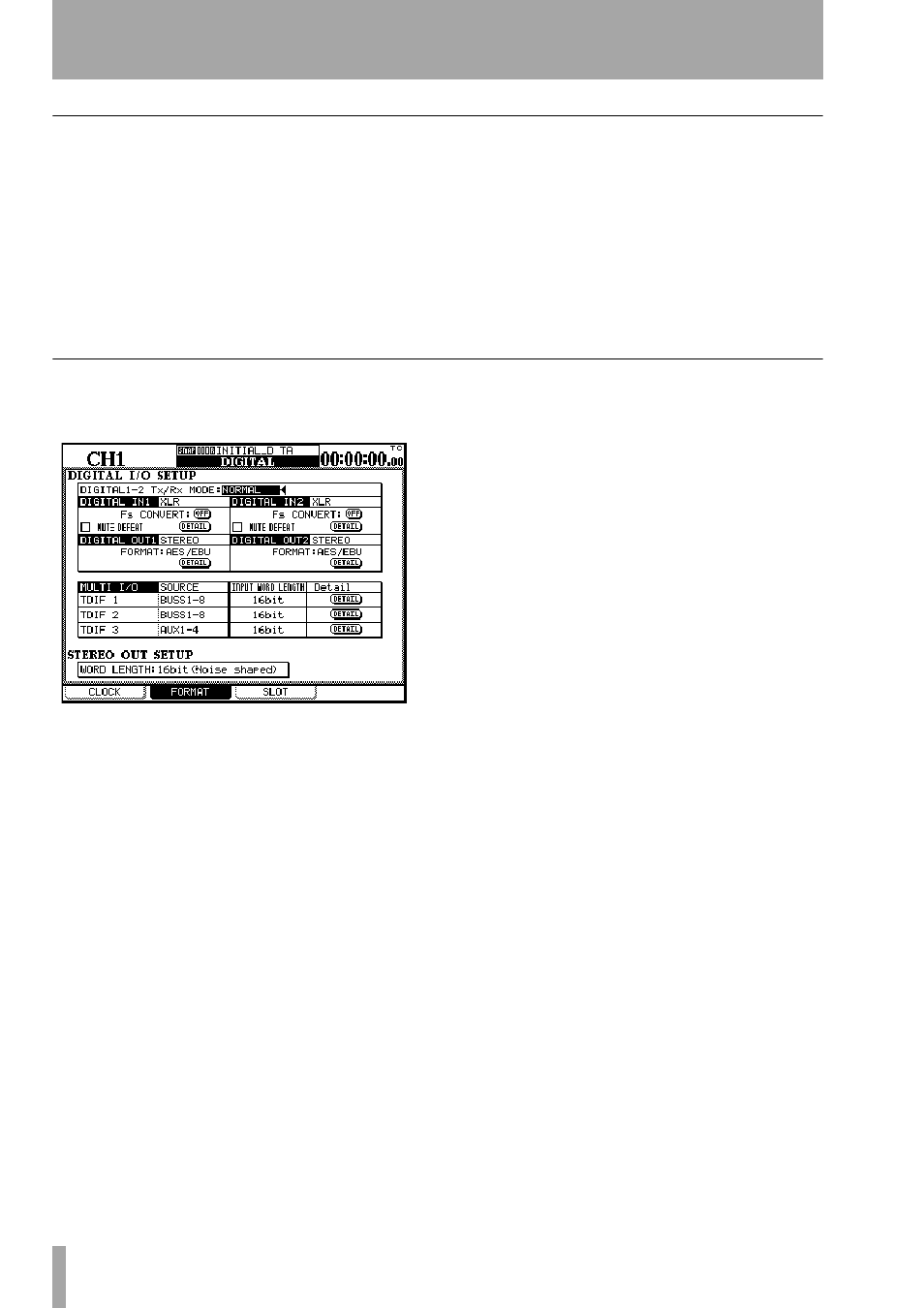Out of range clock signals, The format screen, Type of digital in connection – Teac DM-24 User Manual
Page 26: Other digital input parameters, Digital output, Multi i/o settings, Stereo out setup, Out of range clock signals the format screen, 3 – system-wide options—digital screens

3 – System-wide options—DIGITAL screens
26
TASCAM DM-24 Reference Manual
Out of range clock signals
When setting the clock, the sampling frequency
received can be ±6% of the stated nominal value.
When in use, the frequency can be ±7% of the stated
value. This allows a digital device which has a
varispeed feature to be used as the word clock source
for the DM-24.
If the selected clock source goes out of range, the
DM-24 mutes, the currently-selected clock indicator
flashes, and a message appears on the display.
The DM-24 reports the out-of-range clock frequency
at a range of ±9.9% relative to the stated frequency,
but mutes at 7.0% or over.
Press the
ENTER
key to dismiss the popup message,
change to the
CLOCK
screen, and correct the error
condition (by selecting another clock source, or by
re-selecting the clock if it has come back into range).
The FORMAT screen
This screen allows you to see and work with the digi-
tal audio inputs and outputs connected to the DM-24.
The first part of this screen affects the digital inputs.
Note that the I/O screen is used to determine whether
the XLR connector or RCA pin jack is used for each
of these inputs.
Type of DIGITAL IN connection
Typically,
these connectors will be used for base frequency dig-
ital audio (44.1 k or 48 k). This is shown as
NORMAL
on the display. However, if the DM-24 is in high
sampling frequency mode, these inputs may be used
for high sampling frequency inputs. There are two
ways in which they can be used for high sampling
frequency;
DUAL-LINE
(where one AES/EBU cable is
used to transmit one channel of high sampling fre-
quency audio, hence two lines are needed for a stereo
pair) and
HIGH-SPEED
where the audio is transmitted
at twice the usual speed, where one AES/EBU cable
is used to transmit a pair of high sampling frequency
signals at high speed.
Use the cursor, dial and
ENTER
key to set this value.
If the DM-24 is set to an incompatible sampling fre-
quency, a popup message appears.
Other digital input parameters
At normal
base sampling frequencies, the DM-24 is capable of
performing sampling frequency conversion on the
incoming data. This can be turned on or off individu-
ally using the on-screen
Fs CONVERT
buttons.
The
MUTE DEFEAT
checkbox allows the DM-24 to
ignore a status bit in some implementations of digital
audio, which are otherwise satisfactory. If this is
unchecked, when this audio is received, the input
may be muted and the following messages may be
displayed on screen:
Not Audio data Digital In1
(byte 0,
bit 1=1 of the channel status) or
Source Fs unlocked
(byte 0, bit5=1).
Details of the digital audio data can be obtained from
a popup produced by pressing the
DETAIL
button.
Such information includes the format, type, emphasis
status, etc.
Digital output
The assignments for the two digi-
tal outputs are made using the I/O screen. The format
can be changed between AES/EBU and SPDIF (the
SPDIF
option is meaningful at base sampling frequen-
cies only) and details of the data can be obtained
from a popup produced by pressing the
DETAIL
but-
ton. Such information includes the format, contents,
emphasis status, word length, etc.
Multi I/O settings
These assignments are made
in the I/O screen, and cannot be changed. However,
the word length for each of the TDIF groups can be
set (either
16bit
,
20bit
or
24bit
) and the details can be
viewed (
DETAIL
button). These details include TX/RX
mode, sampling frequency, word length and empha-
sis status, etc.
Stereo out setup
This allows the choice of the
word length output from the stereo out as being
either 24-bit data, 20-bit with noise shaping, or 16-bit
with noise shaping.
